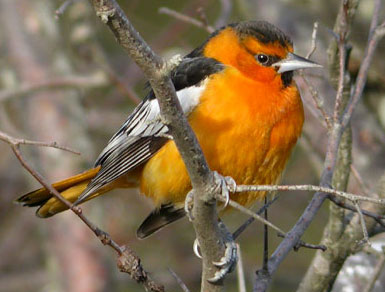You guys rock! I've been coming here for weeks identifying the birds in our backyard for my daughter's school project. Thanks so much for this valuable resource.

East and midwest states. Male pictured above and female below
Adults have a pointed bill and white bars on the wings. The adult male is orange on the underparts, shoulder patch and rump with black everywhere else. The adult female is yellow-brown on the upper parts with darker wings, dull orange on the breast and belly.
Their breeding habitat is the edges of deciduous and mixed woods across eastern North America. The range of this bird overlaps with that of the similar Bullock's Oriole in the midwest, and the two forms were once considered to be conspecific as the Northern Oriole because they form fertile hybrids. The nest is a tightly woven pouch located on the end of a branch, hanging down on the underside.
These birds migrate in flocks to southern Mexico, Central America and northern South America. Some birds may remain near feeders in winter.
These birds forage in trees and shrubs, also making short flights to catch insects. They mainly eat insects, berries and nectar, and are often seen sipping at hummingbird feeders. Oriole feeders contain essentially the same food as hummingbird feeders, but are designed for orioles, and are orange instead of red and have larger perches. The birds are also fond of halved oranges.
Photo © Tim Avery
Photo © Mark Stirland

Found in western states - female is yellower with less black on back and wings.
Adults have a pointed bill. The adult male is orange on the underparts, face and rump with black everywhere else; they have a white wing patch. The adult female is grey-brown on the upper parts, dull yellow on the breast and belly and has wing bars.
Their breeding habitat is the edges of deciduous and mixed woods across western North America. The range of this bird overlaps with that of the similar Baltimore Oriole in the east; these two birds sometimes interbreed where their ranges overlap. The nest is a tightly woven pouch located on the end of a branch.
These birds migrate to Mexico and Central America.
These birds forage in trees and shrubs, also making short flights to catch insects. They mainly eat insects, berries and nectar.
This bird's song is similar to that of the Baltimore Oriole, but faster and somewhat more harsh.
Photo © David Roemer

Found in west.
Adults have a pointed bill and white wing bars. The adult male has an orange head with black on the face and throat; they are black on the back, wings and tail, orange on the underparts. The adult female is olive-green on the upper parts, yellowish on the breast and belly.
Their breeding habitat is open areas with trees, especially palms, across the southwestern United States and northern Mexico. The nest is a tightly woven pouch attached to the underside of a leaf or tree branch.
These birds migrate in flocks to Mexico. Some may over-winter near feeders.
They forage in trees and shrubs, also feeding from flowers. Because it pierces the base of the flower, it does not assist in pollination. These birds mainly eat insects, nectar and fruit.
Photo © Chris Brogdale

Adults have pale stout pointed bills, yellow underparts and light wing bars. Adult males have a bright red face and a yellow nape, shoulder, and rump, with black upper back, wings, and tail; in non-breeding plumage the head has no more than a reddish cast and the body has an olive tinge. Females have a yellow head and are olive on the back, with dark wings and tail.
The song of disconnected short phrases suggests an American Robin's but is hoarser and rather monotonous. The call is described as "pit-er-ick".
Their breeding habitat is coniferous or mixed woods across western North America from the U.S.-Mexican border as far north as southern Alaska; thus they are the northernmost-breeding tanager. They build a flimsy cup nest on a horizontal tree branch, usually in a conifer. They lay four bluish-green eggs with brown spots.
These birds migrate, wintering from central Mexico to Costa Rica. Some also winter in southern California.
These birds are often out of sight, foraging high in trees, sometimes flying out to catch insects in flight. They mainly eat insects, fruits and berries. At times they offer spectacular views, and in much of their range, when a non-birder tells a birder, "I saw the most amazing bird!" the birder can guess it was a male of this species.
Photo © Tim Avery

Adults have pale stout pointed bills. Adult males are bright red with black wings and tail; females are yellowish on the underparts and olive on top, with olive-brown wings and tail. The adult male's winter plumage is similar to the female's, but the wings and tail remain darker.
Their breeding habitat is large forested areas, especially with oaks, across eastern North America. They build a cup nest on a horizontal tree branch.
These birds migrate to northwestern South America. This tanager is an extremely rare vagrant to western Europe.
These birds are often out of sight, foraging high in trees, sometimes flying out to catch insects in flight. They mainly eat insects and berries.
These birds do best in the forest interior, where they are less exposed to predators and nest parasitism by the Brown-headed Cowbird. Their numbers are declining in some areas due to forest fragmentation.
Photo © Tim Avery